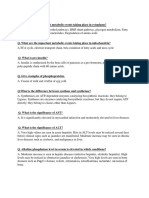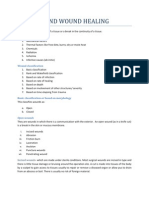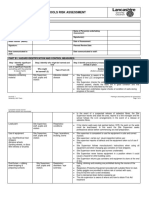Hormonal Secretion of Pancreas
Hormonal Secretion of Pancreas
Uploaded by
Nazia WasimCopyright:
Hormonal Secretion of Pancreas
Hormonal Secretion of Pancreas
Uploaded by
Nazia WasimOriginal Description:
Copyright
Share this document
Did you find this document useful?
Is this content inappropriate?
Copyright:
Hormonal Secretion of Pancreas
Hormonal Secretion of Pancreas
Uploaded by
Nazia WasimCopyright:
HORMONAL SECRETION OF PANCREAS
(PANCREAS 1)
LEARNING OBJECTIVE:
At the end of lecture student should be able to know:
What is pancreas.
Endocrine and exocrine portion of pancreas,
Insulin secretion.
Insulin effects.
Diabetic mellitus
PANCREAS
A triangular gland, A ions which
has both exocrine and
endocrine cells, located behind
the stomach.
A dual organ having two
functions:
o Exocrine Functions.
o Endocrine Functions
o
EXOCRINE FUNCTIONS:
o The exocrine function of the pancreas is localized in the
acinar cells.
o Acinar cells involves synthesis and secretion of digestive
juices pancreatic juice.
o Plays an important role in
the digestion of proteins
and lipids.
o Has mild digestive action
on carbohydrates.
ENDOCRINE
FUNCTIONS:
o Performed by the islets of
Langerhans.
o Involves production of
hormones.
o Human pancreas contain 1 2 million islets.
ISLETS OF LANGERHANS
ORGAN SYSTEMS PANCREAS
A triangular gland.
There are two distinct within the pancreas
The exocrine portion of the pancreas is made up of acini and
ductal systems.
ACINAR CELLS CONTAIN ZYMOGEN
ORGAN SYSTEMS PANCREAS
The endocrine portion of the pancreas is served by
structures called the islet of Langerhans
o The islet of Langerhans have several
distinct cell types
Alpha cells-produce
glucagon and constitute
approximate 25% of the
total islet cell number.
Beta cells-the insulin
producing cells (majority of
the cells)
Delta cells-produce
somatostatin
INSULIN
Hormone of nutrient abundance
A protein hormone consisting of two
amino acid chains linked by disulfide
bonds
Synthesized as part of proinsulin (86 AA)
and then excised by enzymes, releasing functional insulin
(51 AA) and C peptide (29 AA).
Insulin is secreted in response to high blood sugar, although
a low level of insulin is always secreted by the pancreas.
After a meal, the amount of insulin secreted into the blood
increases as the blood glucose rises.
Likewise, as blood glucose falls, insulin secretion by the
pancreatic islet beta cells decreases.
In response to insulin, muscle cells,, and fat cells take
glucose in from the blood, which ultimately lowers the high
blood glucose levels back to the normal range.
Insulin Structure
Large polypeptide 51 AA (MW 6000)
Tow chains linked by disulfide bonds.
A chain (21 AA)
B chain (30 AA)
3 disulfide bonds.
NORMAL INSULIN METABOLISM
Insulin is a peptide hormone composed of 51 aminoacids
that is synthesized, packaged and secreted in the pancreatic
beta cells.
The major regulator of insulin secretion is glucose which acts
both directly and by augmenting the action of other insulin
secretagogues.
A rise in the blood glucose levels, causes an immediate
release of insulin, presumably that is stored in the beta-cell
granules. If the secretory stimulus persists, a delayed
response follows, which involves active synthesis of insulin
from the beta-cells.
Other agents, including intestinal hormones and certain
aminoacids (leucine and arginine), as well as sulfonylureas,
stimulate insulin release.
INSULIN SYNTHESIS
Insulin gene encodes a large precursor of insulin
(preproinsulin)
During translation, the signal peptide is cleaved (proinsulin)
During packaging in granules by Golgi, proinsulin is cleaved
into insulin and C peptide
Protein and Polypeptide Synthesis and Release
Insulin synthesis is stimulated by glucose or feeding and
decreased by fasting.
Threshold of glucose-stimulated insulin secretion is 100
mg/dl.
Glucose rapidly increase the translation of the insulin mRNA
and slowly increases transcription of the insulin gene.
PROTEIN AND POLYPEPTIDE SYNTHESIS AND
RELEASE
INSULIN SYNTHESIS
LEVELS
Blood glucose is normally maintained between 70 mg/dl and
110 mg/dl.
Blood glucose levels below 70mg/dl, denote the situation of
"hypoglycemia".
Although blood glucose levels of 110mg/dl can be normal,
this is only the case if a meal has been taken within 2 to 3
hours.
A blood glucose level of 180mg/dl or more, is termed
"hyperglycemia.
Diagnosis is made if blood glucose levels are above
200mg/dl after drinking a sugar-water drink (glucose
tolerance test).
Insulin excess causes hypoglycemia, which leads to
convulsions and coma.
Insulin deficiency, either absolute or relative, causes
diabetes mellitus (chronic elevated blood glucose), a
complex and debilitating disease that if untreated is
eventually fatal
ISLETS OF LANGERHANS
Islets of Langerhans consists of four types of cells :
o
o
o
o
A cells or cells
B cells or cells
D cells or cells.
F cells or PP cells.
o Alpha cells - release the
hormone glucagon, which
o triggers the release of glycogen form liver stores and
o helps to raise the level of glucose (sugar) in the
o bloodstream.
o Beta cells - release the hormone insulin, which help regulate
carbohydrate metabolism into the bloodstream.
o
o
o
o
o
FUNCTIONS OF INSULIN
Insulin is a major anabolic hormone. It is necessary for:
Transmembrane transport of glucose and aminoacids
Glycogen formation in the liver and skeletal muscles
Glucose conversion to triglycerides
Nucleic acid synthesis
Protein synthesis
Its principal metabolic function is to increase the rate of
glucose transport into certain cells in the body. These are
the striated muscle cells, including myocardial cells,
fibroblasts, and fat cells, representing collectively about 2/3
of the entire bodyweight.
GLUCOSE IS THE PRIMARY STIMULATOR OF INSULIN
SECRETION
o
o
REGULATION OF INSULIN SECRETION
No insulin is produced when plasma glucose below 50 mg/dl
Half-maximal insulin response occurs at 150 mg/dl
A maximum insulin response occurs at 300 mg/dl
Insulin secretion is biphasic:
Upon glucose stimulation an initial burst of secretion (5-15
min.)
Then a second phase of gradual increment that lasts as long
as blood glucose is high
INSULIN SECRETION IS BIPHASIC
INSULIN SIGNALING
INSULIN ACTION ON CELLS:
INSULIN ACTION ON CARBOHYDRATE METABOLISM:
Liver:
Stimulates glucose oxidation
Promotes glucose storage as glycogen
Inhibits glycogenolysis
Inhibits gluconeogenesis
Muscle:
Stimulates glucose uptake (GLUT4)
Promotes glucose storage as glycogen
Insulin Action on Carbohydrate Metabolism
Adipose Tissue:
Stimulates glucose transport into adipocytes
Promotes the conversion of glucose into triglycerides and
fatty acids
GLUCOSE TRANSPORT
GLUT2 (liver, pancreas)
GLUT4, insulin sensitive transporter (muscle, adipose tissue)
GLUT3 (brain)
o
o
o
o
GLYCOGEN SYNTHESIS
Short term storage of glucose
Activates glycogen synthase
Inhibit glycogen phosphorylase
Glycolysis is also stimulated by insulin
Lipogenic and antilipolytic
Insulin promotes lipogenesis and inhibits lipolysis
Promotes formation of -glycerol phosphate and fatty acid
synthesis
Stimulates fatty acid synthase (FAS)
Inhibits hormone sensitive lipase (HSL)
Activates lipoprotein lipase (LPL)
Protein Synthesis and Degradation
Insulin promotes protein accumulation:
Stimulates amino acid uptake
Increases the activity of protein synthesis
Inhibits protein degradation
ACTION OF INSULIN ON LIVER:
ACTION OF INSULIN ON FAT
ACTION OF INSULIN ON MUSCLE
INSULIN ACTION (SUMMARY):
Dominates in Fed State Metabolism.
glucose uptake in most cells
glucose use & storage
protein synthesis
fat synthesis
DIABETES MELLITUS
DIABETES MELLITUS is a syndrome of impaired
carbohydrate, fat, and protein metabolism caused by either
lack of insulin secretion or decreased sensitivity of the
tissues to insulin.
TWO GENERAL TYPES:
o Type I diabetes, insulin-dependent diabetes mellitus
(IDDM):
Caused by lack of insulin secretion.
o Type II diabetes, noninsulin-dependent diabetes
mellitus (NIDDM):
o Caused by decreased sensitivity of target tissues to the
metabolic effect of insulin. This reduced sensitivity to insulin
is often called insulin resistance.
__________________________________________
You might also like
- Redwood Pharma Poison Price List 26.08.2023Document18 pagesRedwood Pharma Poison Price List 26.08.2023suhaime tshNo ratings yet
- Opioid ComplaintDocument190 pagesOpioid ComplaintAnonymous 6f8RIS6No ratings yet
- Diabetes MellitusDocument150 pagesDiabetes MellitusIan Mizzel A. Dulfina100% (2)
- English: Quarter 2, Wk.4 - Module 2Document26 pagesEnglish: Quarter 2, Wk.4 - Module 2Regina Minguez Sabanal100% (1)
- Physiology of The Endocrine PANCREAS and It's Disorders E.G Diabetes MellitusDocument71 pagesPhysiology of The Endocrine PANCREAS and It's Disorders E.G Diabetes MellitusDr. Mahan Josiah MalloNo ratings yet
- The Endocrine Pancreas _ Anatomy and Physiology IIDocument14 pagesThe Endocrine Pancreas _ Anatomy and Physiology IIadnankhan20221984No ratings yet
- Anaphy PancreasDocument6 pagesAnaphy PancreasAELYN SEVILLANo ratings yet
- Pancreas: Cells and Secretions of The Pancreatic IsletsDocument8 pagesPancreas: Cells and Secretions of The Pancreatic IsletsansahNo ratings yet
- Pacreas and Gonads - TILLESDocument7 pagesPacreas and Gonads - TILLESAna Marie D. BorjaNo ratings yet
- Insulin and Glucagon HormonesDocument42 pagesInsulin and Glucagon HormonesRoseNo ratings yet
- Wallah THAK GI ME?Document5 pagesWallah THAK GI ME?Usman EngNo ratings yet
- THE PANCREAS 305Document8 pagesTHE PANCREAS 305mogbadunolaismail2709No ratings yet
- Cells and Secretions of The Pancreatic IsletsDocument4 pagesCells and Secretions of The Pancreatic IsletsSophia OcayNo ratings yet
- تقرير عن البنكرياسDocument23 pagesتقرير عن البنكرياسؤءNo ratings yet
- 4M TheoryDocument10 pages4M TheoryGwenn SalazarNo ratings yet
- Pancreas 2021Document32 pagesPancreas 2021Dr. AliNo ratings yet
- Physiology of PancreasDocument11 pagesPhysiology of Pancreasshtc03m230470No ratings yet
- Pancreas Endocrine Function and Glucose RegulationDocument66 pagesPancreas Endocrine Function and Glucose RegulationnalumenyashakirahNo ratings yet
- Anatomy and PhysiologyDocument10 pagesAnatomy and Physiologykrizzia raymundoNo ratings yet
- Blood Sugar Reg-WPS OfficeDocument8 pagesBlood Sugar Reg-WPS Officetanjidul islamNo ratings yet
- Physiology of The PancreasDocument4 pagesPhysiology of The PancreasClayton VerBerkmösNo ratings yet
- Glucose HomeostasisDocument13 pagesGlucose Homeostasisshreyamahajan010No ratings yet
- Material Estudio Practico 2 BIO135cDocument10 pagesMaterial Estudio Practico 2 BIO135cFelipe Nicolas UrraNo ratings yet
- Insuline HormoneDocument36 pagesInsuline HormoneF ParikhNo ratings yet
- Integration and Interrelation of Metabolism -2021-2022-AymanDocument104 pagesIntegration and Interrelation of Metabolism -2021-2022-AymantariqNo ratings yet
- Hormones and Metabolic RegulationDocument40 pagesHormones and Metabolic RegulationEka HabinaNo ratings yet
- Pancreas Discuss the Organisation and Function of PancreasDocument2 pagesPancreas Discuss the Organisation and Function of PancreasJessica F.No ratings yet
- Endocrine Pancreas & Fuel Homeostasis: Learning ObjectivesDocument7 pagesEndocrine Pancreas & Fuel Homeostasis: Learning ObjectivesEmmanuel NhandaraNo ratings yet
- Anatomy and PhysiologyDocument2 pagesAnatomy and PhysiologyJeffrey Calicdan BucalaNo ratings yet
- Metabolic Syndrome and Diabetes - 200918Document80 pagesMetabolic Syndrome and Diabetes - 200918helena.lovrincevicNo ratings yet
- For PRESENTATIONpancreatichormones 130526052114 Phpapp02Document54 pagesFor PRESENTATIONpancreatichormones 130526052114 Phpapp02Jayniel Erys MollenoNo ratings yet
- Diabetes 1. Normal Physiology/anatomyDocument13 pagesDiabetes 1. Normal Physiology/anatomyJed AbadNo ratings yet
- Diabetes 1. Normal Physiology/anatomyDocument13 pagesDiabetes 1. Normal Physiology/anatomyJed AbadNo ratings yet
- Physiology of Diabetes: Dr. Solomon Sathishkumar. MDDocument36 pagesPhysiology of Diabetes: Dr. Solomon Sathishkumar. MDKhaled LajmiNo ratings yet
- Chapter 13 GlycemiaDocument7 pagesChapter 13 Glycemiakillua zoldyckNo ratings yet
- Endocrine Pancreas Constitute Less Than 2Document5 pagesEndocrine Pancreas Constitute Less Than 2Dratosh KatiyarNo ratings yet
- Homeostasis and The Regulation of Blood GlucoseDocument7 pagesHomeostasis and The Regulation of Blood GlucoseElgin SammonsNo ratings yet
- Post Lab Question Experiment 5Document6 pagesPost Lab Question Experiment 5Skefadiuto100% (3)
- PancreasDocument36 pagesPancreasANZC-chetana singhNo ratings yet
- Hormon DiabeticDocument17 pagesHormon DiabeticNanang Abdul RohmanNo ratings yet
- Seminar BT SEM3 Insulin & GlucagonDocument29 pagesSeminar BT SEM3 Insulin & Glucagonsavithakumar0927No ratings yet
- Why Is The Brain The Most Important Consumer of Glucose?Document11 pagesWhy Is The Brain The Most Important Consumer of Glucose?PojangNo ratings yet
- #3 Pancreatic Hormones & Antidiabetic Drugs 14 PDFDocument14 pages#3 Pancreatic Hormones & Antidiabetic Drugs 14 PDFOmar BasimNo ratings yet
- Assignment of Metabolism 201.Document9 pagesAssignment of Metabolism 201.aa0050250No ratings yet
- Review of Anatomy and PhysiologyDocument7 pagesReview of Anatomy and PhysiologyKyla CalzadoNo ratings yet
- Pansreas - Met.mod.Document19 pagesPansreas - Met.mod.HibyebyeNo ratings yet
- Endo Pancrease ElhDocument27 pagesEndo Pancrease Elhodiodi57No ratings yet
- Endocrine Pancreas - 2010-1Document75 pagesEndocrine Pancreas - 2010-1chidimmaNo ratings yet
- 5 - Insulin & Glucagon HormonesDocument29 pages5 - Insulin & Glucagon HormonesdhenaharcaNo ratings yet
- Regulation of MetabolismDocument42 pagesRegulation of Metabolismامجد حسين جواد كاظمNo ratings yet
- Insulin, Glucagon, and Diabetes MellitusDocument22 pagesInsulin, Glucagon, and Diabetes Mellitusghadeer1No ratings yet
- Insulin Secretion: 1. Pancreatic Beta CellsDocument6 pagesInsulin Secretion: 1. Pancreatic Beta CellsAlicia Tormos EsteveNo ratings yet
- Insulin and The Oral HypoglycemicsDocument9 pagesInsulin and The Oral HypoglycemicsHasibNo ratings yet
- The Endocrine PancreasDocument49 pagesThe Endocrine PancreasaliabumrfghNo ratings yet
- Endocrine Lecture Day 4Document62 pagesEndocrine Lecture Day 4bosssuhayb66No ratings yet
- Lecture (9) Integration of MetabolismDocument40 pagesLecture (9) Integration of MetabolismMahmoud ElazbNo ratings yet
- Endocrine SystemDocument7 pagesEndocrine SystemKelly Camero ÜNo ratings yet
- Wa0032.Document18 pagesWa0032.shreyamahajan010No ratings yet
- Endocrine Pancreas & Fuel Homeostasis: Learning ObjectivesDocument7 pagesEndocrine Pancreas & Fuel Homeostasis: Learning ObjectivesMaggieLockeNo ratings yet
- Insulin, Glucagon, and Diabetes Mellitus: Fatima Abdulwahid Ghadeer AlarayedhDocument22 pagesInsulin, Glucagon, and Diabetes Mellitus: Fatima Abdulwahid Ghadeer Alarayedhghadeer1No ratings yet
- Physio 7Document12 pagesPhysio 7amjadNo ratings yet
- Healthy Habits for Managing & Reversing Prediabetes: 100 Simple, Effective Ways to Prevent and Undo PrediabetesFrom EverandHealthy Habits for Managing & Reversing Prediabetes: 100 Simple, Effective Ways to Prevent and Undo PrediabetesNo ratings yet
- Hypoglycemia, A Simple Guide To The Condition, Treatment And Related ConditionsFrom EverandHypoglycemia, A Simple Guide To The Condition, Treatment And Related ConditionsNo ratings yet
- Formation of Concentrated UrineDocument15 pagesFormation of Concentrated UrineNazia WasimNo ratings yet
- Biochemistry VivaDocument8 pagesBiochemistry VivaNazia WasimNo ratings yet
- JSMU Semester 3 Embrology McqsDocument12 pagesJSMU Semester 3 Embrology McqsNazia WasimNo ratings yet
- JSMU Semester 3 Embrology McqsDocument12 pagesJSMU Semester 3 Embrology McqsNazia WasimNo ratings yet
- Tarlac State University College of Science Department of NursingDocument34 pagesTarlac State University College of Science Department of NursingNicole Anne TungolNo ratings yet
- Parts of A Microwave Oven Magnetron TubeDocument4 pagesParts of A Microwave Oven Magnetron TubesquidblitzNo ratings yet
- PRESENTATION: Effects On Climate On Transovarial Infection Rate of Dengue Virus in Aedes Aegypti (Diptera: Culicidae) MosquitoesDocument34 pagesPRESENTATION: Effects On Climate On Transovarial Infection Rate of Dengue Virus in Aedes Aegypti (Diptera: Culicidae) MosquitoesADB Health Sector GroupNo ratings yet
- Delhi Technological University: Study Material According To Syllabus Given in OrdinanceDocument77 pagesDelhi Technological University: Study Material According To Syllabus Given in OrdinanceHazel JamesNo ratings yet
- NCP Ineffective Gas ExchangeDocument2 pagesNCP Ineffective Gas ExchangeRez ApegoNo ratings yet
- Legal Aspects of Nursing in PanamaDocument14 pagesLegal Aspects of Nursing in PanamaScribdTranslationsNo ratings yet
- Legal and Ethical Aspects of Healthcare 1st Edition S. A. M. Mclean all chapter instant downloadDocument81 pagesLegal and Ethical Aspects of Healthcare 1st Edition S. A. M. Mclean all chapter instant downloadsmulceda100% (7)
- EatingWell On A BudgetDocument10 pagesEatingWell On A BudgetAlice GiffordNo ratings yet
- Swachh Bharat Abhiyan (Clean India Mission) : SWOT Analysis: January 2016Document7 pagesSwachh Bharat Abhiyan (Clean India Mission) : SWOT Analysis: January 2016Brandy BushNo ratings yet
- 2021-05-13 Calvert County TimesDocument24 pages2021-05-13 Calvert County TimesSouthern Maryland OnlineNo ratings yet
- Agoncillo Senior High SchoolDocument10 pagesAgoncillo Senior High SchoolJenjen Maala ImatongNo ratings yet
- CSP-SPM I00 r24Document284 pagesCSP-SPM I00 r24robbertmd100% (1)
- Kuesioner Kinerja PerawatDocument7 pagesKuesioner Kinerja PerawatMuhammad Cholid AlfahroziNo ratings yet
- Surgery, General, Wounds and Wound HealingDocument15 pagesSurgery, General, Wounds and Wound HealingRhazes78100% (1)
- Gluten Free Latvia With Latvian Language Chef Cards For Safe TravelDocument2 pagesGluten Free Latvia With Latvian Language Chef Cards For Safe TravelKim KoellerNo ratings yet
- Hirac 2022Document50 pagesHirac 2022jonnel100% (1)
- N P I Sa M PleDocument1 pageN P I Sa M PleSkyeNo ratings yet
- FTC12LEC WriteUpDocument3 pagesFTC12LEC WriteUpJeremy Dawn CaballeroNo ratings yet
- Lewy Body Dementia SlidesDocument111 pagesLewy Body Dementia SlidesDilini de Silva-Chen100% (1)
- Curriculum Vitae: Dr. Muhammad Junaid SethiDocument5 pagesCurriculum Vitae: Dr. Muhammad Junaid Sethimisbah711No ratings yet
- لقطة شاشة ٢٠٢٤-١٠-٢١ في ٨.٢٧.٤٥ صDocument22 pagesلقطة شاشة ٢٠٢٤-١٠-٢١ في ٨.٢٧.٤٥ صeissa141212No ratings yet
- WorkSafety Assignment 2Document3 pagesWorkSafety Assignment 2hmtrd95No ratings yet
- NFL Concussion Lawsuit Final Approval MemoDocument132 pagesNFL Concussion Lawsuit Final Approval MemoRobert LeeNo ratings yet
- Oral Surgery 1 Final Examination: Good Luck!Document10 pagesOral Surgery 1 Final Examination: Good Luck!Risty FegaridoNo ratings yet
- Product Catalogue 2008 EN-GB PDFDocument101 pagesProduct Catalogue 2008 EN-GB PDFazhan114No ratings yet
- Medicare Obstetrics Services and Costs: An Analysis of Publicly-Available Data 2003-04 To 2013-14Document30 pagesMedicare Obstetrics Services and Costs: An Analysis of Publicly-Available Data 2003-04 To 2013-14Lesley RussellNo ratings yet
- General Schools Risk Assessment: Part A. Assessment DetailsDocument8 pagesGeneral Schools Risk Assessment: Part A. Assessment Detailseng_hmaNo ratings yet




























































































